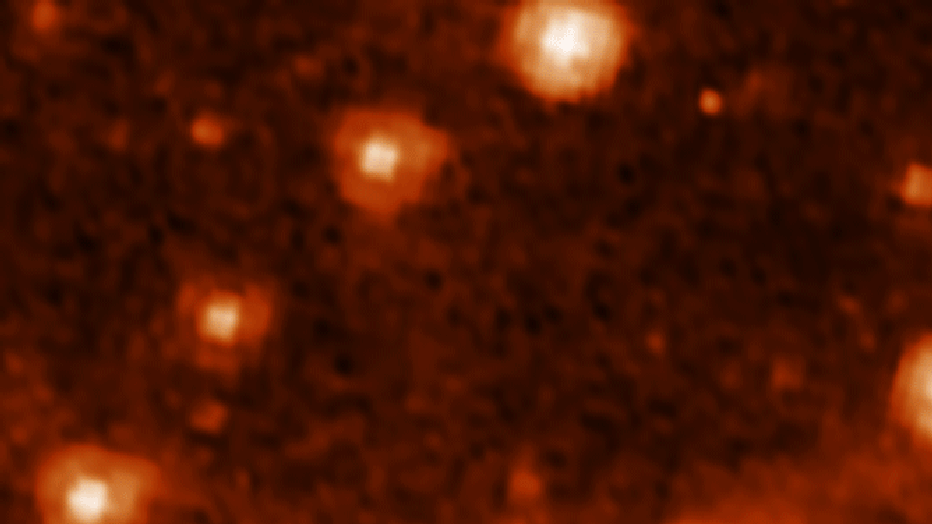First color James Webb Space Telescope image reveals 13-billion-year-old galaxies
NASA’s James Webb Space Telescope has produced the deepest and sharpest infrared image of the distant universe to date. Known as Webb’s First Deep Field, this image of galaxy cluster SMACS 0723 is overflowing with detail.Thousands of galaxies – inclu (NASA, ESA, CSA, and STScI)
President Joe Biden revealed the first color image from NASA's James Webb Space Telescope Monday, resulting from the massive $10 billion observatory looking back into the universe 13 billion years to reveal some of the first galaxies that formed.
NASA, the European Space Agency and Canadian Space Agency plan to release the first full-color images and spectroscopic data from the James Webb Space Telescope on at 10:30 a.m. ET Tuesday. However, before the full photo release, NASA gave the first image to Biden to share with the world during a preview at the White House.
HOW TO WATCH FOX WEATHER ON TV

James Webb Space Telescope launch
NASA's James Webb Space Telescope launched successfully early Christmas morning from French Guiana on South America’s northeastern coast, riding a European Ariane rocket into the sky. Video: NASA
The image is the highest definition image of the most distant galaxies ever taken, according to NASA. It's the first to utilize Deep Field abilities and contains a cluster of galaxies known as SMACS 0723.
If you were to look up at the sky, JWST's first color image known as First Deep Field would be about a grain of sand held out at arm's length by someone on Earth. But yet, the image contains thousands of galaxies with overflowing detail in infrared color.
NASA Administrator Bill Nelson also got a sneak peek of the deep-field view image at NASA headquarters in Washington on Monday before the rest of the world.
"One hundred years ago, we thought there was only one galaxy," Nelson said. "Now the number is unlimited, and in our galaxy, we have billions of stars or suns. And there are billions of galaxies with billions of stars and suns. And we're getting our first glimpse."

The Large Magellanic Cloud, a small satellite galaxy fo the Milky Way, is first shown in images taken by NASA's Spitzer Space Telescope and then in infrared images by the James Webb Space Telescope. (Image credit: NASA/ESA/CSA/STScI; Spitzer: NASA/JP
The light reflected in the James Webb Space Telescope image has been traveling for about 13.5 billion years, Nelson said. The universe is about 13.8 billion years old.
"We're going back almost to the beginning," Nelson said of the universe.
"As an international collaboration, this telescope embodies how America leads the world, not by the example of our power, but the power of our example – a partnership with others," Biden said of JWST. "It symbolizes the relentless spirit of American ingenuity, and it shows what we can achieve, what more we can discover, not just about distant places, but about our very own planet and climate."
WHO WAS JAMES WEBB? THE NAMESAKE BEHIND THE SPACE TELESCOPE

Shown here, the James Webb Space Telescope primary mirror illuminated in a dark cleanroom. (Image: NASA Goddard Space Flight Center)
After launching on Christmas morning, the telescope's 6.5-meter mirror opened, and its tennis-court-size sun shield unfolded in space. The telescope is now stationed about 1 million miles from Earth and, after commissioning, is ready to begin science observations decades in the making.
NASA and its partners have been teasing at Webb's full capabilities as its calibrated the four science instruments on the telescope.
In April, the space agency and its telescope partners released the first image taken after completing "fine phasing" aligning the Optical Telescope Element. Then in May, the Webb science team shared a photo of the Large Magellanic Cloud, a satellite galaxy of the Milky Way, used to test the telescope's Mid-Infrared Instrument or MIRI.
More than six months after launching, Webb is now ready to begin to take precise scientific observations of exoplanets, reveal baby galaxies and unfold secrets of the universe.
'NAILED IT': JAMES WEBB SPACE TELESCOPE'S FIRST IMAGE IS SOMETHING TO CELEBRATE
The image shared by Biden is another preview of what's to come on Tuesday when all the color images are released.
The first color images by James Webb Space Telescope include the largest and brightest nebulae in the universe, the Carina Nebula, located 7,600 light-years away, and WASP-96 b, a gas exoplanet about 1,150 light-years away from Earth. The Southern Ring Nebula, an expanding cloud of gas surrounding a dying star, will also be featured in JWST's first data release. Finally, the compact galaxy group Stephan's Quintet, located in the Pegasus constellation, and a galaxy cluster known as SMACX 0723 will test the observatory's deep field view capabilities.
JWST mission managers said the telescope has enough fuel to continue operations for several decades because of the precise launch trajectory. Its predecessor, the Hubble Space Telescope, continues to operate after more than 30 years in orbit about 300 miles above Earth. NASA astronauts conducted several spacewalks to repair a flaw in Hubble's primary mirror after the first images came back blurry.
CLICK HERE TO GET THE FOX WEATHER UPDATE PODCAST
The James Webb Space Telescope observatory is about 1 million miles from Earth, meaning a repair mission would be out of the question. Thankfully, Webb's first images came back crystal clear.
Check back on FOXweather.com and the FOX Weather app on July 12 to see the images everyone will be talking about.

